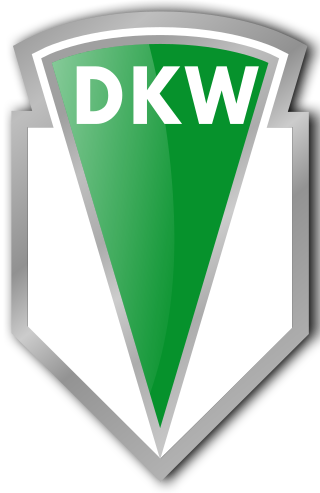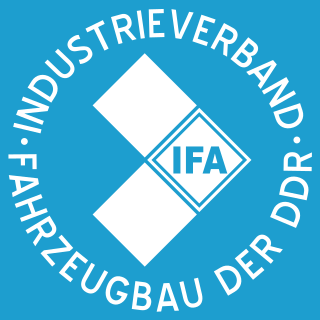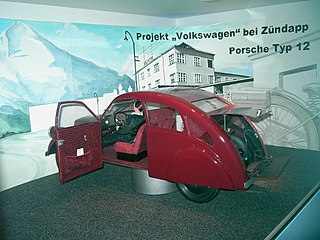
DKW was a German car- and motorcycle-marque. DKW was one of the four companies that formed Auto Union in 1932 and thus became an ancestor of the modern-day Audi company.
Trabant is a series of small cars produced from 1957 until 1991 by former East German car manufacturer VEB Sachsenring Automobilwerke Zwickau. Four models were made: the Trabant 500, Trabant 600, Trabant 601, and the Trabant 1.1. The first model, the 500, was a relatively modern car when it was introduced.

Barkas was the East German manufacturer of small delivery vans and minibuses named the B 1000. In addition to delivery vans, Barkas also made engines for Trabant cars.

Ursaab, also known as 92001 and X9248, was the first of four prototype cars made by Saab AB, which at that time was solely an aeroplane manufacturer, leading to production of the first Saab car, the Saab 92 in 1949. The car is now in the Saab Car Museum in Trollhättan. The name "Ursaab" means "original Saab".

The Opel Calibra is a coupé, engineered and produced by the German automaker Opel between 1989 and 1997. In the United Kingdom, where it remained on sale until 1999, it was marketed under the Vauxhall brand as the Vauxhall Calibra. It was also marketed as the Chevrolet Calibra in South America by Chevrolet, and the Holden Calibra in Australia and New Zealand by Holden.

Front-wheel drive (FWD) is a form of engine and transmission layout used in motor vehicles, in which the engine drives the front wheels only. Most modern front-wheel-drive vehicles feature a transverse engine, rather than the conventional longitudinal engine arrangement generally found in rear-wheel-drive and four-wheel-drive vehicles.

In automotive design, a front-engine, front-wheel-drive (FWD) layout, or FF layout, places both the internal combustion engine and driven roadwheels at the front of the vehicle.
Economy car is a term mostly used in the United States for cars designed for low-cost purchase and operation. Typical economy cars are small, lightweight, and inexpensive to both produce and purchase. Stringent design constraints generally force economy car manufacturers to be inventive. Many innovations in automobile design were originally developed for economy cars, such as the Ford Model T and the Austin Mini.

The Standard Superior was an automobile, produced from 1933 to 1935 by Standard Fahrzeugfabrik of Ludwigsburg, Germany, founded by motorcycle maker Wilhelm Gutbrod and unrelated to the Standard Motor Company of England. These small cars were designed according to the patents by Josef Ganz and featured rear-mounted two-stroke engines.

A transverse engine is an engine mounted in a vehicle so that the engine's crankshaft axis is perpendicular to the direction of travel. Many modern front-wheel drive vehicles use this engine mounting configuration. Most rear-wheel drive vehicles use a longitudinal engine configuration, where the engine's crankshaft axis is parallel with the direction of travel, except for some rear-mid engine vehicles, which use a transverse engine and transaxle mounted in the rear instead of the front. Despite typically being used in light vehicles, it is not restricted to such designs and has also been used on armoured fighting vehicles to save interior space.

Industrieverband Fahrzeugbau, usually abbreviated as IFA, was a conglomerate and a union of companies for vehicle construction in the former East Germany.
The Automobilwerk Eisenach (AWE) was an automobile manufacturer in Eisenach, Germany.

The Wartburg was a carmaker known for its East German manufactured models, but has its origins dating to 1898. The name derives from Wartburg Castle on one of the hills overlooking the town of Eisenach where the cars were made. From the 1950s, Wartburgs were a three-cylinder two-stroke engine with only seven major moving parts. Production ended in April 1991, and the factory was acquired by Opel.

The Wartburg 353, known in some export markets as the Wartburg Knight, is a medium-sized family car, produced by the East German car manufacturer AWE for their Wartburg brand. It was the successor of the Wartburg 311, and was itself succeeded by the Wartburg 1.3.

The Volkswagen Group MLB platform is the company's platform strategy, announced in 2012, for shared modular construction of its longitudinal, front-engined automobiles.

The Wartburg 311 is a car produced by East German car manufacturer VEB Automobilwerk Eisenach from 1956 to 1965. The 311 model was manufactured in a number of variations, including pickup, sedan, limousine, coupé, and as a two-seat roadster. The two-stroke engine was enlarged to 992 cc in 1962. An interim model, called the Wartburg 312 and featuring the chassis developed for the succeeding 353, was built from 1965 until 1967.

Opel Eisenach GmbH is a German manufacturing company based at Eisenach in Thuringia, Germany and a subsidiary of Opel. It currently produces the Opel Grandland.

The Porsche Type 12 was a German project to develop an "Everyman's automobile" for Zündapp. Fritz Neumeyer, then owner of Zündapp, ordered Ferdinand Porsche to design and build the prototype in 1931. Eventually, two saloons, and one drophead coupé were built. All of those cars were lost during World War II, the last one in a bombing raid in Stuttgart in 1945. The Type 12 is considered an important early step in the development of the original Volkswagen. A replica of the Type 12 is on static display at the Museum Industrielkultur in Nürnberg.

A platform chassis is a form of vehicle frame / automobile chassis, constructed as a flat plate or platform, sometimes integrating a backbone or frame-structure with a vehicle's floor-pan.

RGW-Auto was a joint project for the construction of passenger cars in the former East Germany and Czechoslovakia. Both countries were members of Comecon. The aging Trabant 601, Wartburg 353, Škoda 100 and Dacia 1300 were to be replaced by vehicles with a modern design. The manufacturers involved were Automobilwerk Eisenach (Wartburg), Sachsenring Automobilwerke Zwickau (Trabant), AZNP Mladá Boleslav (Škoda) and Uzina de Autoturisme Pitești (Dacia). Mass production of the ambitious project was to begin in 1978, but it never happened.

























